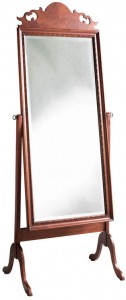
Hepplewhite, a namesake movement in furniture design, was one of transition. Named after English furniture maker George Hepplewhite, this furniture was a bit of fresh air from the extravagant display that was Victorian era furniture.
Hepplewhite furniture was popular for a span of about 30 years, from around 1780-1910 to be more specific.
He succeeded in creating a style that proved ornate and elegant can also be clean and fresh. Standout features of this style include straight legs (opposed to cabriole legs popular during the Queen Anne period) that were often fluted and boasted tapered or squared legs.
Lines had clean curves that had more of a muted elegance, often in the form of unique carvings and ribbon, tree and feather motifs or painted designs.
H-stretchers between the legs of large sofas and some chairs were also signatures of the style. Due to the legs’ reserved styling, spade and arrow feet were commonly used, as well as bracket feet in larger items.
Hepplewhite’s furniture was especially popular “across the pond” and was often seen in many states along the Eastern seaboard.
The subtle use of round geometric shapes and curvature in furniture backs and arms certainly helped the furniture achieve its notoriety.
About a century after his death, British manufacturers tried to recreate some of Hepplewhite’s collections. Imitation is said to be the highest form of flattery, but is regrettably no match for the real thing.
